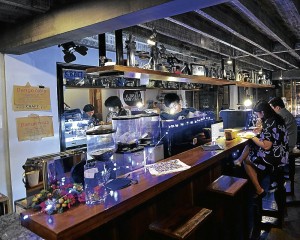
This is a bit of a departure for me, not just in topic and from my usual restaurant coverage, but from my usual Makati haunts.
Craft Coffee Workshop is not difficult to find, but tucked away at the corner of Broadway and E. Rodriguez, one wouldn’t stumble upon it unexpectedly. It’s small, independent and everything and everyone inside is intensely fanatical about coffee.
Coffee snobbery frightens me, in the same way that wine snobbery does: I’m afraid of being found out for the fraud that I am. Like an art poseur caught unawares at a museum, I take refuge in the mantra of “Well, I’m no expert but I know what I like.” When I’m asked to comment on a wine I’ve been given to taste, I parry with a literary reference. “Have read any Günter Grass?”
“No, I’m afraid I haven’t.”
“Well, if Günter Grass were a wine, it would be just like this. Günter Grass crossed with a bit of Jeffrey Eugenides.”
Complex world
Just as I take shelter in the predictability of the ubiquitous Rhône wines when faced with an extensive wine list of exotic and daunting choices, the comforting familiarity of branded coffee like Illy and Lavazza have been there to allay my insecurities in the face of the complex world of bouquets, acidity, body and the multitudes of infinite variables that are computed, analyzed and discussed as you sip of a cup from the Third Wave of Coffee.
This term refers to the attempt to bring artisanal sensibilities to commercialized espresso bars with their exceptionally gregarious baristas, which are the second wave of coffee—the first being, presumably, all that has gone before, i.e., simply drinking it.
Emblematically, the first thing you see upon entering Craft Coffee Workshop is a large roaster. Roasting one’s own beans, creating one’s own blends and sourcing the green beans as directly as possible are basic tenets of this movement.
Guilty secret
Raising coffee to an art form is something that can breed both snobs and geeks, and I’m happy to report that the team at Craft Coffee Workshop, led by Sly Samonte, is of the latter. Once I had confessed to them the guilty secret that I used a fully automatic bean-to-cup machine to make my morning cup of very milky and sugary coffee, he set about making a cup of cappuccino for me and my wife, talking us through the steps, patiently answering questions.
He may have given this spiel hundreds of times, but he had the kind of fanatical zealot’s gleam in his eyes, the kind I get when some unfortunate soul makes the mistake of asking me questions about tube amplifiers or Vespas.
It might have been all a bit too much, had he not produced the best-tasting cup of coffee I have ever had: silky smooth, just milky enough to feel rich in the mouth, but with an unmistakable punch of coffee aroma permeating through it all, the opposite of most espresso bars where you are bathed in a wonderfully promising scent of coffee, but are then presented with a tepid wash of barely flavored milk under a net of bubbles.
Slow brew
But this was only the beginning. We had to try the Clover, we were told. To try this, we had to move a few seats down the bar, and a few notches further into the world of coffee geekery.
The Clover is a very expensive ($11,000) piece of machinery that is like a very complicated and precise French press; it gives you every bit of flavor that a bean has to offer, extracted and presented to you unadulterated. It was given to us in a wine glass. This one seemed a bit tame after the explosion of aroma in the espresso, more like a kind of delicate coffee-flavored tea. “It’s a bit mild,” I said, not knowing what I was getting into.
Then I must try a slow brew, Sly said, and we were whisked to the far end of the coffee bar that ran down the length of the shop. We were presented with an innocent-looking cup of black coffee that, like all the other coffees in the shop, did not need any sugar and tasted properly of coffee without being overly bitter or acidic.
After a few sips, I was grabbing people by the collar and telling them, at great length, about the novel I was planning to write, which, at that moment, seemed fully formed in my head. By the time I reached the bottom of the cup, my eyes were rolling in their sockets and Ihadtowritethatnovelnownownow! and so we raced back to Makati going around corners on two wheels.
Shabu-crazed bus drivers took one look at me and pulled over to the side to give way and let us whiz by. It was well past midnight before I got to sleep; my wife went to bed at 8 p.m., the following day.
What it was and how it was made, I have no recollection. I can only suggest, in no uncertain terms, that if you care at all about coffee or even if you don’t, you owe it to yourself to make a trip there and try a cup for yourself.
I can’t describe how good it is, except that it tastes a bit like Günter Grass.
Craft Coffee Workshop is at 66 Broadway Ave., New Manila, Quezon City; tel. 5703464